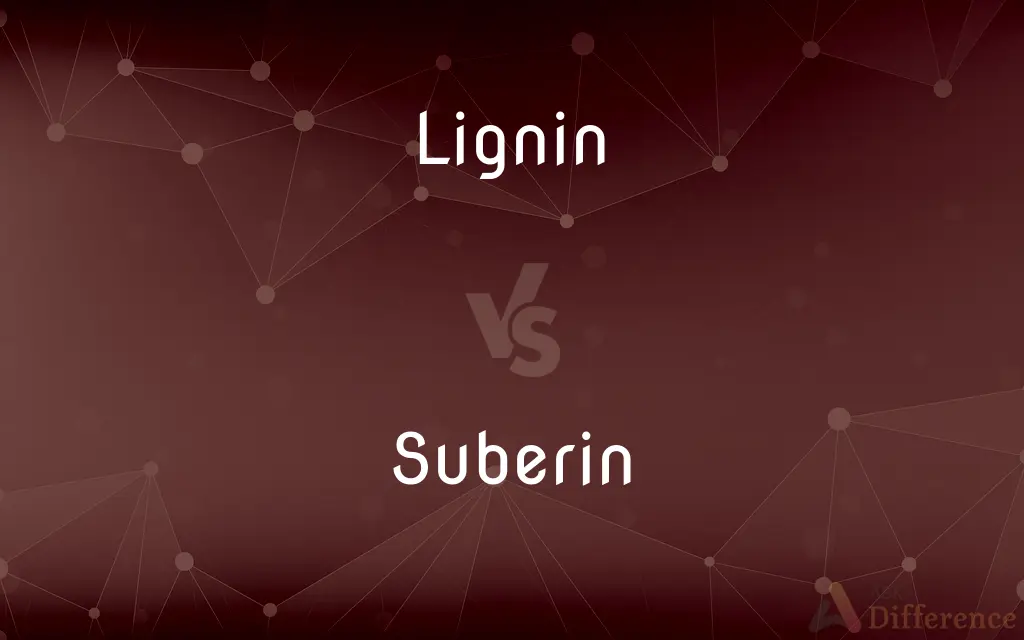Lignin vs. Suberin — What's the Difference?
By Tayyaba Rehman — Updated on October 31, 2023
Lignin is an organic polymer that strengthens and supports plant cell walls, while Suberin is a waxy substance that waterproofs and protects certain plant tissues.

Difference Between Lignin and Suberin
Table of Contents
ADVERTISEMENT
Key Differences
Lignin is a complex aromatic polymer that provides rigidity to plants, especially in woody tissues; Suberin, however, is a complex fatty polymer primarily found in the cell walls of cork cells and certain other plant tissues.
The presence of Lignin in plant cell walls makes them rigid, helping the plant maintain its structure; on the other hand, Suberin provides a barrier against water and pathogenic invaders.
As plants grow, Lignin accumulates in the secondary cell wall, contributing to the woodiness of stems and branches; in contrast, Suberin is instrumental in the formation of cork layers, such as those observed in tree barks.
Both Lignin and Suberin play critical roles in the plant's defense. While Lignin confers mechanical strength to resist environmental stresses, Suberin acts as a physical and biochemical barrier to external threats.
Comparison Chart
Primary Location
Secondary cell walls of plants, especially woody tissues
Cell walls of cork cells
ADVERTISEMENT
Main Function
Provides rigidity and support to plant tissues
Waterproofs and protects plant tissues
Composition
Complex aromatic polymer
Complex fatty polymer
Role in Plant Growth
Contributes to woodiness of stems and branches
Forms cork layers in barks
Associated with
Wood formation
Cork formation
Compare with Definitions
Lignin
A substance involved in wood formation.
The process of pulping involves breaking down lignin to obtain cellulose fibers.
Suberin
A waxy substance found in the cell walls of cork cells.
Suberin provides a natural barrier in cork oak bark.
Lignin
A component responsible for the rigidity in plants.
The reduction of lignin can make plants more digestible for herbivores.
Suberin
An essential component in cork formation.
Tree barks rich in suberin have good insulating properties.
Lignin
A natural composite that reinforces cellulose fibers.
Decomposing lignin is a challenge in paper recycling.
Suberin
A protective barrier against pathogenic invaders in plants.
Suberin deposition is a defense response in injured plant tissues.
Lignin
A complex organic polymer found in plant cell walls.
The high lignin content makes hardwoods particularly durable.
Suberin
A complex fatty polymer present in various plant tissues.
The presence of suberin is what makes cork impermeable to water.
Lignin
The second most abundant biopolymer after cellulose.
Research on lignin utilization can lead to sustainable bio-based materials.
Suberin
A compound responsible for waterproofing in certain plants.
The suberin layer in roots prevents excessive water uptake.
Lignin
Lignin is a class of complex organic polymers that form key structural materials in the support tissues of most plants. Lignins are particularly important in the formation of cell walls, especially in wood and bark, because they lend rigidity and do not rot easily.
Suberin
Suberin, cutin and lignins are complex, higher plant epidermis and periderm cell-wall macromolecules, forming a protective barrier. Suberin, a complex polyester biopolymer, is lipophilic, and composed of long chain fatty acids called suberin acids, and glycerol.
Lignin
A complex polymer, the chief noncarbohydrate constituent of wood, that binds to cellulose fibers and hardens and strengthens the cell walls of plants.
Suberin
A waxy waterproof substance present in the cell walls of certain plant tissues, especially cork.
Lignin
(organic compound) A complex non-carbohydrate aromatic polymer present in all wood.
Suberin
A waxy material found in the cell walls of cork and similar plants
Lignin
A substance characterizing wood cells and differing from cellulose in its conduct with certain chemical reagents.
Suberin
A material found in the cell walls of cork. It is a modification of lignin.
Lignin
A complex polymer; the chief non-carbohydrate constituent of wood; binds to cellulose fibers to harden and strengthen cell walls of plants
Common Curiosities
What is the primary function of Lignin in plants?
Lignin provides rigidity and support to plant tissues, especially woody ones.
Does Lignin contribute to the woodiness of plants?
Yes, Lignin accumulation in plant cell walls contributes to their woodiness.
Where is Suberin primarily found?
Suberin is primarily found in the cell walls of cork cells.
Does Suberin have any protective role in plants?
Yes, Suberin acts as a physical and biochemical barrier against external threats.
Is Lignin present in all plants?
While many plants have Lignin, its concentration varies, with woody plants having higher amounts.
Why is Suberin considered waterproof?
Suberin acts as a barrier against water, making tissues like cork impermeable.
Are there any commercial uses for Suberin?
Yes, cork, which is rich in Suberin, is used for products like wine stoppers and flooring.
Is Lignin a type of carbohydrate?
No, Lignin is an organic polymer, distinct from carbohydrates like cellulose.
How does Lignin impact the paper industry?
Lignin needs to be removed in the pulping process to obtain high-quality paper.
Why are cork products resistant to moisture?
The high Suberin content in cork makes it resistant to moisture.
Can Lignin be broken down easily?
Lignin is resilient and challenging to decompose, making it durable in nature.
How do Lignin and Suberin differ in composition?
Lignin is a complex aromatic polymer, while Suberin is a complex fatty polymer.
What role does Suberin play in tree barks?
Suberin is instrumental in forming the cork layers observed in tree barks.
Are Lignin and Suberin types of fibers?
No, Lignin is a polymer that reinforces cellulose fibers, and Suberin is a waxy substance in cork cells.
Are Lignin and Suberin only found in specific plants?
While many plants contain Lignin and Suberin, their concentrations and locations vary depending on the plant species.
Share Your Discovery

Previous Comparison
Aurora vs. Nebula
Next Comparison
Seminar vs. WorkshopAuthor Spotlight
Written by
Tayyaba RehmanTayyaba Rehman is a distinguished writer, currently serving as a primary contributor to askdifference.com. As a researcher in semantics and etymology, Tayyaba's passion for the complexity of languages and their distinctions has found a perfect home on the platform. Tayyaba delves into the intricacies of language, distinguishing between commonly confused words and phrases, thereby providing clarity for readers worldwide.














































